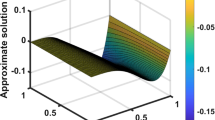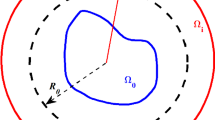Abstract
Hepatitis-B is a highly infectious disease and causes many worldwide deaths. In this article, a mathematical model of hepatitis-B virus is described. The optimal existence and optimality conditions for the existence of solutions of the concerned model are established. The numerical behavior of the continuous system, susceptible–exposed–acute–carrier–hospitalized–recovered, of hepatitis-B virus is also discussed. Stability of the equilibrium points is studied using Routh–Hurwitz stability criteria. To study this model numerically, a nonstandard finite difference (NSFD) scheme is designed which has the most important features, for instance, unconditional stability, positivity and convergence of the continuous system. Basic reproduction number \(R_0\) that imparts a decisive role in disease prediction as well as stability analysis is described. It is observed that disease vanishes when the value of \(R_0\) is less then unity and it persists for \(R_0>1\). Stability analysis is carried out, and two bench mark results for the system to be locally asymptotically stable are established. Comparison of the NSFD scheme with two renowned techniques, RK-4 and Forward Euler’s method, is shown in this study. Numerical simulations show that proposed NSFD scheme is convergent to the steady states at all step sizes. It shows that the proposed scheme is independent of the step size while the other two existing schemes do not observe this property. Also, the other methods do not preserve some of the main conditions of the continuous system at certain time steps.







Similar content being viewed by others
References
L. Zou, W. Zhang, S. Ruan, Modeling the transmission dynamics and control of hepatitis-B virus in China. J. Theor. Biol. 262(2), 330–338 (2010)
World Health Organization. http://www.who.int/news-room/fact-sheets/detail/hepatitis-B (2019)
S.A. Ali, R.M. Donahue, H. Qureshi, S.H. Vermund, Hepatitis-B and hepatitis-C in Pakistan: prevalence and risk factors. Int. J. Infect. Dis. 13(1), 9–19 (2009)
M.A. Khan, S. Islam, J.C. Valverde, S.A. Khan, Control strategies of hepatitis B with three control variables. J. Biol. Syst. 26, 1–21 (2018)
M.A. Khan, S. Islam, G. Zaman, Media coverage campaign in hepatitis B transmission model. Appl. Math. Comput. 331, 378–393 (2018)
Y. Nakata, T. Kuniya, Global dynamics of a class of SEIRS epidemic models in a periodic environment. J. Math. Anal. Appl. 363(1), 230–237 (2010)
H.W. Hethcote, The mathematics of infectious diseases. SIAM Rev. 42(4), 599–653 (2000)
R.E. Mickens, Nonstandard Finite Difference Models of Differential Equations (World Scientific, Singapore, 1994)
W. Qin, L. Wang, X. Ding, A non-standard finite difference method for a hepatitis-B virus infection model with spatial diffusion. J. Differ. Equ. Appl. 20(12), 1641–1651 (2014)
J. Cresson, F. Pierret, Non standard finite difference scheme preserving dynamical properties. J. Comput. Appl. Math. 303, 15–30 (2016)
M. Suleman, S. Riaz, Unconditionally stable numerical scheme to study the dynamics of hepatitis-B disease. Punjab Univ. J. Math. 49, 99–118 (2017)
N. Ahmed, N. Shahid, Z. Iqbal, M. Jawaz, M. Rafiq, S.S. Tahira, M.O. Ahmad, Numerical modeling of SEIQV epidemic model with saturated incidence rate. J. Appl. Environ. Biol. Sci 8(4), 67–82 (2018)
N. Ahmed, S.S. Tahira, M. Rafiq, M.A. Rehman, M. Ali, M.O. Ahmad, Positivity preserving operator splitting nonstandard finite difference methods for SEIR reaction diffusion model. Open Math. 17(1), 313–330 (2019)
J.E. Macías-Díaz, N. Ahmed, M. Rafiq, Analysis and nonstandard numerical design of a discrete three-dimensional hepatitis-B epidemic model. Mathematics 7(12), 1157 (2019)
A.Z. Zaher, A.M.A. Moawad, K.S. Mekheimer, M.M. Bhatti, Residual time of sinusoidal metachronal ciliary flow of non-Newtonian fluid through ciliated walls: fertilization and implantation. Biomech. Model Mechanobiol. (2021). https://doi.org/10.1007/s10237-020-01405-5
L. Zhang, M.M. Bhatti, M. Marin, K.S. Mekheimer, Entropy analysis on the blood flow through anisotropically tapered arteries filled with magnetic zinc-oxide (ZnO) nanoparticles. Entropy 22, 1070 (2020). https://doi.org/10.3390/e22101070
L. Zou, W. Zhang, S. Ruan, Modeling the transmission dynamics and control of hepatitis B virus in China. J. Theor. Biol. 21(262), 330–338 (2010). https://doi.org/10.1016/j.jtbi.2009.09.035
J. Li, Z. Ma, Qualitative analyses of SIS epidemic model with vaccination and varying total population size. Math. Comput. Model. 1(35), 1235–1243 (2002). https://doi.org/10.1016/S0895-7177(02)00082-1
S. Ullah, M.A. Khan, J.F. Gómez-Aguilar, Mathematical formulation of hepatitis-B virus with optimal control analysis. Optim. Control Appl. Methods 40(3), 529–544 (2019)
P. Van den Driessche, J. Watmough, Reproduction numbers and sub-threshold endemic equilibria for compartmental models of disease transmission. Math. Biosci. 180(1–2), 29–48 (2002)
W.J. Edmunds, G.F. Medley, D.J. Nokes, The transmission dynamics and control of hepatitis-B virus in The Gambia. Stat. Med. 15(20), 2215–2233 (1996)
C.W. Shepard, E.P. Simard, L. Finelli, A.E. Fiore, B.P. Bell, Hepatitis-B virus infection: epidemiology and vaccination. Epidemiologic Rev. 28(1), 112–125 (2006)
J. Pang, J.A. Cui, X. Zhou, Dynamical behavior of a hepatitis-B virus transmission model with vaccination. J. Theor. Biol. 265(4), 572–578 (2010)
World Health Organization. Pakistan. http://www.who.int/countries/pak/en/. Accessed May 15 (2016)
G.F. Medley, N.A. Lindop, W.J. Edmunds, D.J. Nokes, Hepatitis-B virus endemicity: heterogeneity, catastrophic dynamics and control. Nat. Med. 7(5), 619–624 (2001)
World Health Organization. Hepatitis-B. http://www.who.int/mediacentre/factsheets/fs204/en/. Accessed July 1 (2016)
Acknowledgements
The authors would like to thank the Deanship of Scientific Research at Majmaah University for supporting this work under Project R-2021-50.
Author information
Authors and Affiliations
Corresponding author
Ethics declarations
Conflict of Interest
The authors declare no conflict of interest.
Rights and permissions
About this article
Cite this article
Shaikh, T.S., Fayyaz, N., Ahmed, N. et al. Numerical study for epidemic model of hepatitis-B virus. Eur. Phys. J. Plus 136, 367 (2021). https://doi.org/10.1140/epjp/s13360-021-01248-8
Received:
Accepted:
Published:
DOI: https://doi.org/10.1140/epjp/s13360-021-01248-8




